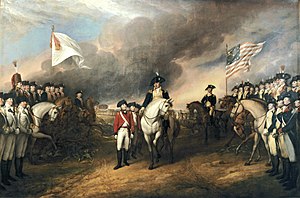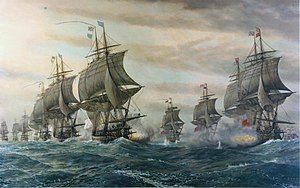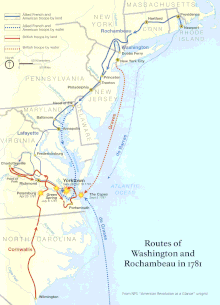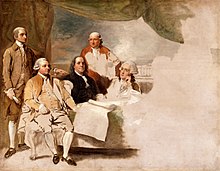France in the American Revolutionary War


French involvement in the American Revolutionary War of 1775–1783 began in 1776[1] when the Kingdom of France secretly shipped supplies to the Continental Army of the Thirteen Colonies when it was established in June 1775. France was a long-term historical rival with the Kingdom of Great Britain, from which the Colonies were attempting to separate.
A
France's help was a major and decisive contribution towards the United States' eventual victory and independence in the war. However, as a cost of participation in the war, France accumulated over 1 billion livres in debt, which significantly strained the nation's finances. The French government's failure to control spending (in combination with other factors) led to unrest in the nation, which eventually culminated in a revolution a few years after the conflict between the US and Great Britain concluded. Relations between France and the United States thereafter deteriorated, leading to the Quasi-War in 1798.
American origins of the conflict
After its defeat in the Seven Years' War in 1763, France lost all of its far holdings in North America. Meanwhile, the American colonists and the British government began to fight over whether Parliament in London or the colonial assemblies had primary responsibility for taxation. As part of that conflict, the colonists organized the Boston Tea Party in response to a tax on tea. The British government responded by passing the Intolerable Acts, which included the closing of Boston Harbor and the revocation of Massachusetts's colonial charter.[2] This conflict exacerbated tensions further. The ideological conflict escalated into open warfare in 1775, at which point the American patriots revolted against British rule. France, who had been rebuilding their Navy and other forces, saw this as a perfect opportunity to avenge her defeat in the previous war and severely undermine her nemesis. [3]
French involvement
France bitterly resented its loss in the Seven Years' War and sought revenge. It also wanted to strategically weaken Britain. Following the
Motivated by the prospect of glory in battle or animated by the sincere ideals of liberty and republicanism, volunteers such as
Debate over quiet aid or declaring open war
Up against the British power, the young nation lacked arms and allies, and so it turned towards France. France was not directly interested in the conflict, but saw it as an opportunity to contest British power by supporting a new British opponent. Through negotiations conducted first by Silas Deane and then by Benjamin Franklin, France began covert support of the patriots' cause.
Secretly approached by
Public opinion in France was in favor of open war, but King Louis and his advisors were reluctant due to the possible risks and heavy expenses involved. The king's economic and military advisors, in particular, remained reluctant. The
The Americans argued that an alliance of the United States, France, and Spain would assure a rapid defeat of the British, but Vergennes, waiting until his navy was ready, hesitated. On July 23, 1777, Vergennes decided that it was time to decide either total assistance, with war, or abandonment of the new nation. The choice, ratified by the king, was war.[6]
Entry into the war
The British had taken
France formally recognized the United States on February 6, 1778, with the signing of the
France did consider the landing of 40,000 men in the nearby British Isles but abandoned the idea because of logistical issues. On the continent, France was protected through its alliance with Austria which, even if it did not take part in the American Revolutionary War, affirmed its diplomatic support of France.
Other nations in Europe at first refused to openly join the war but both Spain and the Dutch Republic gave unofficial support to the American cause. Vergennes was able to convince the Spanish to formally enter the war in 1779 and, in 1780, Britain declared war on the Dutch Republic over claims of Dutch violations of neutrality.
North American operations

French participation in North America was initially maritime in nature and marked by some indecision on the part of its military leaders. In 1778, American and French planners organized an attempt to capture Newport, Rhode Island, then under British occupation. The attempt failed, in part because Admiral d'Estaing did not land French troops prior to sailing out of Narragansett Bay to meet the British fleet. He then sailed to Boston after his fleet was damaged in a storm. In 1779, d'Estaing again led his fleet to North America for joint operations, this time against British-held Savannah, Georgia. About 3,000 French joined with 2,000 Americans in the Siege of Savannah, in which a naval bombardment was unsuccessful. An attempted assault of the entrenched British position was repulsed with heavy losses.
Support became more notable when, in 1780, 6,000 soldiers led by Rochambeau landed at Newport, itself abandoned in 1779 by the British, and then established a naval base there. These forces were largely inactive since the fleet was closely watched by the British fleet from its bases in New York and eastern Long Island. By early 1781, with the war dragging on, French military planners were finally convinced that more significant operations would be required in North America to bring a decisive end to the war. That year's West Indies fleet was commanded by the comte de Grasse, and specific arrangements were made to coordinate operations with him. De Grasse asked to be supplied with North American pilots and to be informed of possible operations in North America to which he might contribute. Rochambeau and Washington met in Wethersfield, Connecticut in May 1781 to discuss their options. Washington wanted to drive the British from both New York City and Virginia (the latter led first by Benedict Arnold, then by Brigadier William Phillips and eventually by Charles Cornwallis). Virginia was also seen as a potent threat that could be fought with naval assistance. These two options were dispatched to the Caribbean along with the requested pilots. Rochambeau, in a separate letter, urged de Grasse to come to the Chesapeake Bay for operations in Virginia. Following the Wethersfield conference, Rochambeau moved his army to White Plains, New York and placed his command under Washington.
De Grasse received these letters in July at roughly the same time Cornwallis was preparing to occupy Yorktown, Virginia. De Grasse concurred with Rochambeau and subsequently sent a dispatch indicating that he would reach the Chesapeake at the end of August but that agreements with the Spanish meant he could only stay until mid-October. The arrival of his dispatches prompted the Franco-American army to begin a march for Virginia. De Grasse reached the Chesapeake as planned and his troops were sent to assist Lafayette's army in the blockade of Cornwallis's army. A British fleet sent to confront de Grasse's control of the Chesapeake was defeated by the French on September 5 at the Battle of the Chesapeake and the Newport fleet delivered the French siege train to complete the allied military arrival. The Siege of Yorktown and following surrender by Cornwallis on October 19 were decisive in ending major hostilities in North America.[8]
Other battles

Other important battles between the French and the British were spaced out around the world, from the West Indies to India. France's navy at first dominated in the West Indies, capturing
In European waters, France and Spain joined forces with the entry of Spain into the war in 1779. An
In
Peace negotiations
Because of decisive battles on American soil, the French were in a strong position during the peace negotiations in Paris at the beginning of 1782. Rodney's victory at the Battle of the Saintes back in April however changed all that – news of the French defeat arrived nearly six weeks later in France and was met with dismay. The defeat was costly militarily and financially. The Royal Navy now had the strategic initiative, and as a result British demands at the peace talks greatly strengthened.[10] France was also approaching the limits of its ability to borrow money and now sought a quick end to the war. The defeat also signalled a collapse in the Franco-American alliance – as a result Benjamin Franklin never informed France of the secret negotiations that took place directly between Britain and the United States.[11]
The British position was strengthened even more in September with the destruction of the Franco-Spanish assault on Gibraltar and the garrison's relief by the Royal Navy the following month.[9] A preliminary peace treaty between Great Britain and America was signed on 30 November; Britain acknowledged that the United States owned all the land south of the Great Lakes and east of the Mississippi River, except for Florida (which went to Spain). The French accepted the preliminary with protests but no action. Since France was not included in the American-British peace discussions the influence of France and Spain in future negotiations was limited.[12]
Aftermath

With the Americans split from their allies the war formally ended in September 1783 with the signing of the
Because the French involvement in the war was distant and naval in nature, over a billion livres tournois were spent by the French government to support the war effort, raising its overall debt to about 3.315 billion. The finances of the French state were in disastrous shape and were made worse by Jacques Necker, who, rather than increase taxes, used loans to pay off debts. State secretary of Finances Charles Alexandre de Calonne attempted to fix the deficit problem by asking for the taxation of the property of nobles and clergy but was dismissed and exiled for his ideas. The French instability further weakened the reforms that were essential in the re-establishment of stable French finances. Trade also severely declined during the war, but was revived by 1783.
The war was especially important for the prestige and pride of France, who was reinstated in the role of European arbiter. However, Great Britain, not France, became the leading trading partner of the United States.
Financial aspects
In all the French spent 1.3 billion livres to support the Americans directly in addition to the money it spent fighting Britain on land and sea outside the U.S.[15][16][17]
France's status as a great modern power was re-affirmed by the war, but it was detrimental to the country's finances. Even though France's European territories were not affected, victory in a war against Great Britain with battles like the decisive siege of Yorktown in 1781 had a large financial cost which severely degraded fragile finances and increased the national debt. France gained little except that it weakened its main strategic enemy and gained a new, fast-growing ally that could become a welcome trading partner. However, the trade never materialized, and in 1793 the United States proclaimed its neutrality in the war between Great Britain and the French Republic.[18]
Some historians argue that France primarily sought revenge against Great Britain for the loss of territory in North America and India from the previous conflict. But Jonathan R. Dull states that France intervened because of dispassionate calculation, not because of
See also
- Pedro Pablo Abarca de Bolea, 10th Count of Aranda
- Benjamin Franklin Bache
- Edward Bancroft
- William Carmichael
- Jacques-Donatien Le Ray de Chaumont
- Anne Emmanuel de Croÿ
- Jacques Barbeu-Dubourg
- Edward Edwards, British spy
- Franco-American alliance
- William Franklin
- William Temple Franklin
- Conrad Alexandre Gérard de Rayneval
- Rodolphe-Ferdinand Grand, banker, along with his brother Georges, to America
- Anne-Catherine de Ligniville, Madame Helvétius
- Ralph Izard
- John Jay
- John Paul Jones
- Anne-César de La Luzerne
- Louis-Léon de Brancas, comte de Lauraguais
- Henry Laurens
- John Laurens
- Antoine Lavoisier
- Jean-Charles-Pierre Lenoir
- Jean-Baptiste Le Roy
- Louis-Guillaume Le Veillard
- List of French units in the American Revolutionary War
- Jean-Frédéric Phélypeaux, comte de Maurepas
- André Morellet
- Antoine de Sartine
- David Murray, 2nd Earl of Mansfield, The Viscount Stormont
- Paul Wentworth
- Lambert Wickes
References
Notes
- JSTOR 1904500.
- ^ "1774: Parliament passes the Boston Port Act". History Channel. Retrieved 20 December 2017.
- ^ Hoffman, Ronald, and Peter J. Albert, eds. Diplomacy and Revolution: The Franco-American Alliance of 1776 (the United States Capitol Historical Society, 1981)
- ^ Journal of the American Revolution, "The Gunpowder shortage" (September 9, 2013).[1]
- JSTOR 1918776
- ISBN 9781417985364.
- ISBN 978-0547225647.
- ISBN 9781462095049.
- ^ a b Allison & Ferreiro 2018, pp. 220–21.
- ^ Tombs & Tombs 2010, p. 178.
- ^ Dull 1975, pp. 283–84.
- ^ Richard B. Morris, The Peacemakers: The Great Powers and American Independence (1975)
- ISBN 9780815304425.
- ISBN 9780898759785.
- ISBN 9781429907996.
- ^ Christopher Hodson and Brett Rushforth, "Bridging the Continental Divide: Colonial America's 'French Quarter.'" OAH Magazine of History 25.1 (2011): 19-24.
- ISBN 9780522866971.
- ISBN 9780871691804.
- ^ Jonathan R. Dull, The French Navy and American Independence: A Study of Arms and Diplomacy, 1774-1787 (1975)
English
- Allison, David K; Ferreiro, Larrie D, eds. (2018). The American Revolution: A World War. Smithsonian Institution. ISBN 9781588346599.
- Bemis, Samuel Flagg. The Diplomacy of the American Revolution (1935)
- Brown, John L. "Revolution and the Muse: the American War of Independence in Contemporary French Poetry." William and Mary Quarterly 1984 41(4): 592–614. doi:10.2307/1919155
- Brecher, Frank W. Securing American Independence: John Jay and the French Alliance. Praeger Publishers, 2003. Pp. xiv, 327 online
- Chartrand, René, and Back, Francis. The French Army in the American War of Independence Osprey; 1991.
- Corwin, Edward S. French Policy and the American Alliance of 1778 Archon Books; 1962.
- Dull, Jonathan R. A Diplomatic History of the American Revolution; Yale U. Press, 1985.
- Dull, Jonathan R. (1975). The French Navy and American Independence: A Study of Arms and Diplomacy, 1774-1787. Princeton University Press. ISBN 978-0-691-64467-7.
- Kaplan, Lawrence S. "The Diplomacy of the American Revolution: the Perspective from France." Reviews in American History 1976 4(3): 385–390. review of Dull (1975) JSTOR 2701454
- Gottschalk, Louis. Lafayette Comes to America 1935 online; Lafayette Joins the American Army (1937)
- Hoffman, Ronald and Albert, Peter J., ed. Peace and the Peacemakers: The Treaty of 1783. U. Press of Virginia, 1986. 263 pp.
- Hoffman, Ronald and Albert, Peter J., ed. Diplomacy and Revolution: The Franco-American Alliance of 1778. U. Press of Virginia, 1981. 200 pp.
- Hudson, Ruth Strong. The Minister from France: Conrad-Alexandre Gérard, 1729–1790. Lutz, 1994. 279 pp.
- Hutson, James H. John Adams and the Diplomacy of the American Revolution (1980)
- Kennett, Lee. The French Forces in America, 1780–1783.Greenwood, 1977. 188 pp.
- Kramer, Lloyd. Lafayette in Two Worlds: Public Cultures and Personal Identities in an Age of Revolutions. (1996). 355 pp.
- Morris, Richard B. "The Great Peace of 1783," Massachusetts Historical Society Proceedings (1983) Vol. 95, pp 29–51.
- Morris, Richard B. The Peacemakers: The Great Powers and American Independence (1975)
- Perkins, James Breck. France in the American Revolution 1911 online
- Popofsky, Linda S. and Sheldon, Marianne B. "French and American Women in the Age of Democratic Revolution, 1770–1815: a Comparative Perspective." History of European Ideas1987 8(4–5): 597–609. ISSN 0191-6599
- Pritchard, James. "French Strategy and the American Revolution: a Reappraisal." Naval War College Review 1994 47(4): 83–108. ISSN 0028-1484
- Schaeper, Thomas J. France and America in the Revolutionary Era: The Life of Jacques-Donatien Leray de Chaumont, 1725–1803. Berghahn Books, 1995. 384 pp. He provided military supplies.
- Tombs, Isabelle; Tombs, Robert (2010). That Sweet Enemy: The British and the French from the Sun King to the Present. Random House. ISBN 9781446426234.
- Unger, Harlow Giles. Lafayette Wiley, 2002 online
- Van Tyne, C. H. "Influences which Determined the French Government to Make the Treaty with America, 1778," American Historical Review (1916) 21#3 pp. 528–541 JSTOR 1835010
- Van Tyne, C. H. "French Aid Before the Alliance of 1778," American Historical Review (1925) 31#1 pp. 20–40 JSTOR 1904500
Primary sources
- Lafayette, Marquis de. Lafayette in the Age of the American Revolution: Selected Letters and Papers, 1776–1790. Vol. 2: April 10, 1778–March 20, 1780. Cornell U. Press, 1979. 518 pp.
French
- Susan Mary Alsop, Les Américains à la cour de Louis XVI, 1982. Traduction française : Jean-Claude Lattès (1983).
- Henri Haeau, Complot pour l'Amérique 1775–1779, Paris, Éditions Robert Laffont, 1990, ISBN 2-221-05364-8
- J.-M. Bizière et J. Sole, Dictionnaire des Biographies, Paris, Éditions du Seuil, 1993.
- Olivier Chaline, La France au XVIIIe siècle (1715–1787), Paris, Éditions Belin, 1996.
- Joël Cornette, Absolutisme et Lumière 1652–1783, collection Carré Histoire, Paris, Éditions Hachette, 2000. ISBN 2-01-145422-0
- Jean Egret, Necker, ministre de Louis XVI, 1776–1790, Honoré Champion; Paris, 1975.
- André Zysberg, La Monarchie des Lumières (1775–1786), Paris, Éditions du Seuil, 2002.
